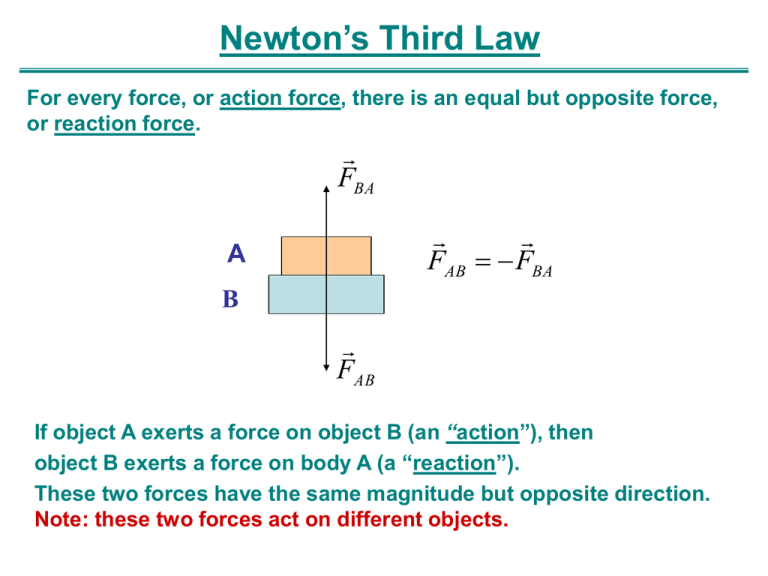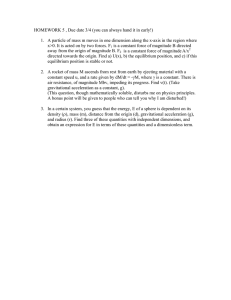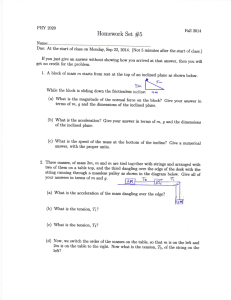Newton's Third Law: Action-Reaction Forces Explained
advertisement

Newton’s Third Law For every force, or action force, there is an equal but opposite force, or reaction force. FBA FAB FBA A B FAB If object A exerts a force on object B (an “action”), then object B exerts a force on body A (a “reaction”). These two forces have the same magnitude but opposite direction. Note: these two forces act on different objects. Example: Two carts are put back-to-back on a track. Cart A has a springloaded piston; cart B, which has twice the mass of cart A, is entirely passive. When the piston is released, it pushes against cart B, and the carts move apart. Which of the two forces exerted by the two carts on each other has a larger magnitude? It’s a third law pair!! 1. The force exerted by A. 2. The two forces have equal magnitude. 3. The force exerted by B. B A Example: Gravitation. You attract the Earth! F g you,Earth = Fg Earth, you But the acceleration that this produces on the Earth is your weight (70 kg)(10 m/s 2 ) 22 2 a 10 m/s , 24 MEarth 6 10 kg nothing to be too proud of… Free Body Diagram Example: Book on Table – The full story NBT WBE NTE Action-Reaction Pairs: Normal force between book and table NBT = –NTB Gravitational force between book and earth WBE = –WEB Normal force between table and earth NTE = –NET WTE WET NTB WEB NET Gravitational force between table and earth WTE = –WET The book does not accelerate WBE+NBT=0 The table does not accelerate WTE+NTB+NTE=0 Does the earth accelerate? Example: Two blocks of masses m and 2m are pushed together along a horizontal, frictionless surface by a force F. m F A 2m B 1) What is the magnitude of the net force on block B ? A. 1/3 F Entire system: Fnet,all ( F ) 3ma B. 2/3 F Block A: Fnet,A ma C. F Block B: Fnet,B 2ma 2 (so ma F ) 3 F 3 2) What is the magnitude of the force on block A by block B? A. 1/3 F FAB FBA f B. 2/3 F C. F Block A : Block B : F f ma f 2ma NB NA FAB F A mg FBA B 2mg 2 f F 3 Example 1: A box with a mass of 100kg is given an upward acceleration of 2.2m/s² by a cable. What is the tension in the cable? T m=100kg a=2.2m/s2 T=? Newton’s equation: T-mg=ma T=m(g+a) m mg T=100kg*(9.8 m/s2 +2.2 m/s2 )= 1200 N Note: this tension is bigger than the box’s weight, w=mg=100 kg* 9.8 m/s2 = 980 N Example 2: The same box as in example 1 is given an downward acceleration of 2.2m/s² by a cable. What is the tension in the cable? m = 100 kg a = -2.2 m/s2 T=? T=m(g+a) T=100 kg*(9.8 m/s2 -2.2 m/s2 )= 760 N Note: this tension is smaller than the box’s weight, w=mg=100kg* 9.8m/s2 = 980N Compare examples 1 & 2: the tension depends on acceleration & is independent from velocity. The tension is equal to the weight if there is now acceleration (a=0). Example: A fish is being yanked upward out of the water with a line that can stand a maximum tension of 180 N. The string snaps when the acceleration of the fish is 8 m/s2. What is the mass of the fish? A. 8 kg T B. 10 kg C. 18 kg mg T mg ma T 180 N m 10 kg 2 g a 10 8m / s Example: Two boxes hang from the ceiling of an accelerated elevator T1 a m1 m1g T2 m2 m2 g Upper box: T1 T2 m1 g m1 a Lower box: T2 m2 g m2 a T2 m2 g a T1 T2 m1 g a m1 m2 g a Example: John has a mass of 100 kg and standing on a scale in an elevator which is accelerating upwards from rest at 2 m/s². What will the scale read? Non John, by scale a What does a scale measure? The magnitude of the normal force on the scale by John, |NJS|= |NSJ| (not part of John’s free body diagram) Newton’s 2nd law on John: NJS mJ g mJa Won John, by Earth NJS WJE mJ a mJ g a John moves with the elevator Note: In this course, the word “weight” refers to mg, not to what a scale reads. (100 kg)(9.8 m/s2 2.0 m/s2 ) 1180 N Non scale, by John If the scale is in kg, it will read: NJS 1180 N 120 kg g 9.8 m/s2 Example: A hand keeps a 20-kg box from sliding down a frictionless incline. The plane of the incline makes an angle θ = 30° with the horizontal. What is the magnitude of the force exerted by hand? mgsinθ – F = m ax = 0 F = mg sinθ N – mgcosθ = m ay = 0 N = mg cosθ y F = (20 kg)(9.8 m/s2)sin(30°) = 98 N N FB,hand x mgcosθ mgsinθ Directions: θ mg •Draw the free-body diagram θ • Choose axes (draw them!) • Use Newton’s 2nd law in the x and y-directions.



